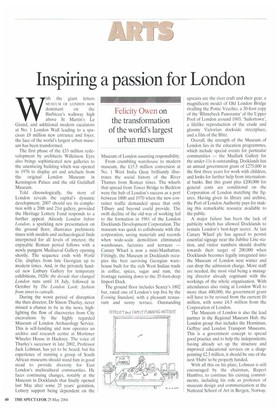Inspiring a passion for London
With the giant letters MUSEUM OF LONDON flow
dominant on the Barbican's walkway high above St Martin's Le Grand, and additional modern escalators at No. 1 London Wall leading to a spacious £8 million new entrance and foyer, the face of the world's largest urban museum has been transformed.
The first phase of the £33 million redevelopment by architects Wilkinson Eyre also brings sophisticated new galleries to the unenticing building which was opened in 1976 to display art and artefacts from the original London Museum in Kensington Palace and the old Guildhall Museum.
Told chronologically, the story of London reveals the capital's dynamic development; 2007 should see its completion with a 20th and 21st gallery, provided the Heritage Lottery Fund responds to a further appeal. Already London before London, a sparkling new presentation on the ground floor, illustrates prehistoric times with models and archaeological finds interpreted for all levels of interest; the enjoyable Roman period follows with a newly pungent Mediaeval Gallery opening shortly. The sequence ends with World City, displays from late Georgian up to modern times. And, in the privately funded new Linbury Gallery for temporary exhibitions, 1920s: the decade that changed London runs until 18 July, followed in October by The London Look: fashion from street to catwalk.
During the worst period of disruption the then director, Dr Simon Thurley, never missed a chance to be in the news, highlighting the flow of discoveries from City excavations by the highly regarded Museum of London Archaeology Service. This is self-funding and now operates an archive and research centre at Mortimer Wheeler House in Hackney. The voice of Thurley's successor in late 2002, Professor Jack Lohman, has yet to be heard, but his experience of running a group of South African museums should stand him in good stead to provide diversity for East London's multicultural communities. He faces continuing changes, notably at the Museum in Docklands that finally opened last May after some 25 years' gestation, Lottery support being dependent on the Museum of London assuming responsibility.
From crumbling warehouse to modern museum, the £15.5 million conversion at No. 1 West India Quay brilliantly illustrates the social history of the River Thames from Roman times. The wharfs that spread from Tower Bridge to Beckton were the hub of London's success as a port between 1800 and 1970 when the new container traffic demanded space that only Tilbury and beyond could provide. The swift decline of the old way of working led to the formation in 1981 of the London Docklands Development Corporation. The museum was quick to collaborate with the corporation, saving materials and records when wide-scale demolition eliminated warehouses, factories and terraces — Canary Wharf is now a mini-Manhattan. Fittingly, the Museum in Docklands occupies the best surviving Georgian warehouse built for the rich West Indian trade in coffee, spices, sugar and rum, the frontage running down to the 35-foot-deep Import Dock.
The ground floor includes Searcy's 1802 bar, rated one of London's top five by the Evening Standard, with a pleasant restaurant and sunny terrace. Outstanding upstairs are the river craft and their gear, a magnificent model of Old London Bridge rivalling the Ponte Vecchio, a 30-foot copy of the 'Rhinebeck Panorama' of the Upper Pool of London around 1803, `Sailortown', a lifelike reproduction of the crude and gloomy Victorian dockside streetplace, and a film of the Blitz.
Overall, the strength of the Museum of London lies in the education programmes, which include special events for particular communities — the Mudlark Gallery for the under-11s is outstanding. Docklands has an annual government grant of £275,000 in the first three years for work with children, and looks for further help from international banks. But this grant plus £200,000 for general costs are conditional on the Corporation of London matching the figures. Having given its library and archive, the Port of London Authority pays for making this remarkable resource available to the public.
A major failure has been the lack of publicity which has allowed Docklands to remain London's best-kept secret. At last Canary Wharf plc has agreed to permit essential signage near the Jubilee Line station, and visitor numbers should double towards their target of 200,000 when Docklands becomes legally integrated into the Museum of London next winter and can drop the admission charge. More staff are needed, the most vital being a managing director already cognisant with the workings of the whole organisation. With attendances also rising at London Wall to more than 400,000, the government grant will have to be revised from the current £6 million, with some £4.5 million from the Corporation of London.
The Museum of London is also the lead partner in the Regional Museum Hub, the London group that includes the Horninnan, Geffrye and London Transport Museums. This is a government concept to spread good practice and to help the independents; having already set up the structure and improved educational services on a disappointing £2.3 million, it should be one of the next 'Hubs' to be properly funded.
With all this on his plate, Lohman is still encouraged by the chairman, Rupert Hambro, to continue his existing commitments, including his role as professor of museum design and communication at the National School of Art in Bergen, Norway. This may require only two and a half weeks a year, but it leads to a higher international profile and subsequent demands on his time.
The Museum's stated mission is to 'inspire a passion for London', something the director feels strongly. The organisation is well prepared to involve different cultures, and Lohman, with his light touch and ability to delegate, is an agreeable figure. It has to be said, however, that the few museums which reach their potential owe it to the vision and dedication of their leader, and Lohman may find himself handicapped by demands on his time from abroad.



































































 Previous page
Previous page